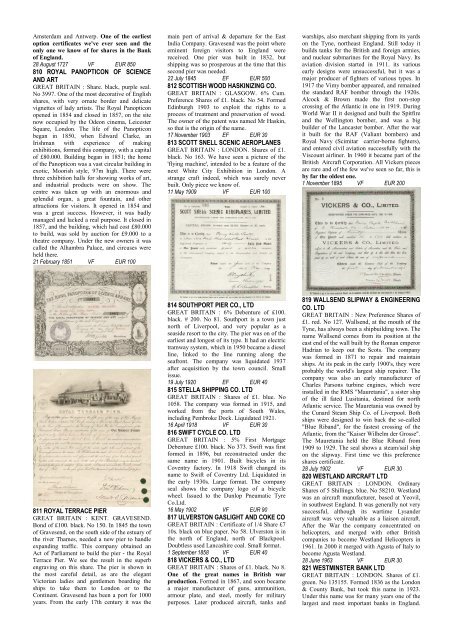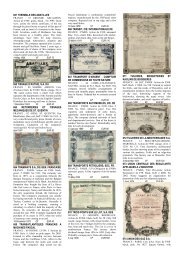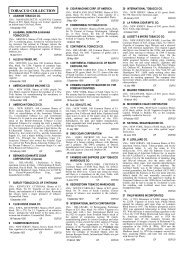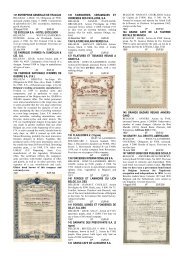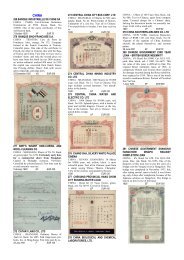You also want an ePaper? Increase the reach of your titles
YUMPU automatically turns print PDFs into web optimized ePapers that Google loves.
Amsterdam and Antwerp. One <strong>of</strong> <strong>the</strong> earliest<br />
option certificates we've ever seen and <strong>the</strong><br />
only one we know <strong>of</strong> for shares in <strong>the</strong> Bank<br />
<strong>of</strong> England.<br />
28 August 1727 VF EUR 850<br />
810 ROYAL PANOPTICON OF SCIENCE<br />
AND ART<br />
GREAT BRITAIN : Share. black, purple seal.<br />
No 3997. One <strong>of</strong> <strong>the</strong> most decorative <strong>of</strong> English<br />
shares, with very ornate border and delicate<br />
vignettes <strong>of</strong> lady artists. The Royal Panopticon<br />
opened in 1854 and closed in 1857, on <strong>the</strong> site<br />
now occupied by <strong>the</strong> Odeon cinema, Leicester<br />
Square, London. The life <strong>of</strong> <strong>the</strong> Panopticon<br />
began in 1850, when Edward Clarke, an<br />
Irishman with experience <strong>of</strong> making<br />
exhibitions, formed this company, with a capital<br />
<strong>of</strong> £80.000. Building began in 1851; <strong>the</strong> home<br />
<strong>of</strong> <strong>the</strong> Panopticon <strong>was</strong> a vast circular building in<br />
exotic, Moorish style, 97m high. There were<br />
three exhibition halls for showing works <strong>of</strong> art,<br />
and industrial products were on show. The<br />
centre <strong>was</strong> taken up with an enormous and<br />
splendid organ, a great fountain, and o<strong>the</strong>r<br />
attractions for visitors. It opened in 1854 and<br />
<strong>was</strong> a great success. However, it <strong>was</strong> badly<br />
managed and lacked a real purpose. It closed in<br />
1857, and <strong>the</strong> building, which had cost £80.000<br />
to build, <strong>was</strong> sold by auction for £9.000 to a<br />
<strong>the</strong>atre company. Under <strong>the</strong> new owners it <strong>was</strong><br />
called <strong>the</strong> Alhambra Palace, and circuses were<br />
held <strong>the</strong>re.<br />
21 February 1851 VF EUR 100<br />
811 ROYAL TERRACE PIER<br />
GREAT BRITAIN : KENT. GRAVESEND.<br />
Bond <strong>of</strong> £100. black. No 150. In 1845 <strong>the</strong> town<br />
<strong>of</strong> Gravesend, on <strong>the</strong> south side <strong>of</strong> <strong>the</strong> estuary <strong>of</strong><br />
<strong>the</strong> river Thames, needed a new pier to handle<br />
expanding traffic. This company obtained an<br />
Act <strong>of</strong> Parliament to build <strong>the</strong> pier - <strong>the</strong> Royal<br />
Terrace Pier. We see <strong>the</strong> result in <strong>the</strong> superb<br />
engraving on this share. The pier is shown in<br />
<strong>the</strong> most careful detail, as are <strong>the</strong> elegant<br />
Victorian ladies and gentlemen boarding <strong>the</strong><br />
ships to take <strong>the</strong>m to London or to <strong>the</strong><br />
Continent. Gravesend has been a port for 1000<br />
years. From <strong>the</strong> early 17th century it <strong>was</strong> <strong>the</strong><br />
main port <strong>of</strong> arrival & de<strong>part</strong>ure for <strong>the</strong> East<br />
India Company. Gravesend <strong>was</strong> <strong>the</strong> point where<br />
eminent foreign visitors to England were<br />
received. One pier <strong>was</strong> built in 1832, but<br />
shipping <strong>was</strong> so prosperous at <strong>the</strong> time that this<br />
second pier <strong>was</strong> needed.<br />
22 July 1845 EF EUR 500<br />
812 SCOTTISH WOOD HASKINIZING CO.<br />
GREAT BRITAIN : GLASGOW. 6% Cum.<br />
Preference Shares <strong>of</strong> £1. black. No 54. Formed<br />
Edinburgh 1903 to exploit <strong>the</strong> rights to a<br />
process <strong>of</strong> treatment and preservation <strong>of</strong> wood.<br />
The owner <strong>of</strong> <strong>the</strong> patent <strong>was</strong> named Mr Haskin,<br />
so that is <strong>the</strong> origin <strong>of</strong> <strong>the</strong> name.<br />
17 November 1903 EF EUR 30<br />
813 SCOTT SNELL SCENIC AEROPLANES<br />
GREAT BRITAIN : LONDON. Shares <strong>of</strong> £1.<br />
black. No 163. We have seen a picture <strong>of</strong> <strong>the</strong><br />
'flying machine', intended to be a feature <strong>of</strong> <strong>the</strong><br />
next White City Exhibition in London. A<br />
strange craft indeed, which <strong>was</strong> surely never<br />
built. Only piece we know <strong>of</strong>.<br />
11 May 1909 VF EUR 100<br />
814 SOUTHPORT PIER CO., LTD<br />
GREAT BRITAIN : 6% Debenture <strong>of</strong> £100.<br />
black. # 200. No 81. Southport is a town just<br />
north <strong>of</strong> Liverpool, and very popular as a<br />
seaside resort to <strong>the</strong> city. The pier <strong>was</strong> on <strong>of</strong> <strong>the</strong><br />
earliest and longest <strong>of</strong> its type. It had an electric<br />
tramway system, which in 1950 became a diesel<br />
line, linked to <strong>the</strong> line running along <strong>the</strong><br />
seafront. The company <strong>was</strong> liquidated 1937<br />
after acquisition by <strong>the</strong> town council. Small<br />
issue.<br />
19 July 1920 EF EUR 40<br />
815 STELLA SHIPPING CO. LTD<br />
GREAT BRITAIN : Shares <strong>of</strong> £1. blue. No<br />
1058. The company <strong>was</strong> formed in 1915, and<br />
worked from <strong>the</strong> ports <strong>of</strong> South Wales,<br />
including Pembroke Dock. Liquidated 1921.<br />
16 April 1918 VF EUR 30<br />
816 SWIFT CYCLE CO. LTD<br />
GREAT BRITAIN : 5% First Mortgage<br />
Debenture £100. black. No 373. Swift <strong>was</strong> first<br />
formed in 1896, but reconstructed under <strong>the</strong><br />
same name in 1901. Built bicycles in its<br />
Coventry factory. In 1918 Swift changed its<br />
name to Swift <strong>of</strong> Coventry Ltd. Liquidated in<br />
<strong>the</strong> early 1930s. Large format. The company<br />
seal shows <strong>the</strong> company logo <strong>of</strong> a bicycle<br />
wheel. Issued to <strong>the</strong> Dunlop Pneumatic Tyre<br />
Co.Ltd.<br />
16 May 1902 VF EUR 90<br />
817 ULVERSTON GASLIGHT AND COKE CO<br />
GREAT BRITAIN : Certificate <strong>of</strong> 1/4 Share £7<br />
10s. black on blue paper. No 58. Ulverston is in<br />
<strong>the</strong> north <strong>of</strong> England, north <strong>of</strong> Blackpool.<br />
Doubtless used Lancashire coal. Small format.<br />
1 September 1858 VF EUR 40<br />
818 VICKERS & CO., LTD<br />
GREAT BRITAIN : Shares <strong>of</strong> £1. black. No 8.<br />
One <strong>of</strong> <strong>the</strong> great names in British war<br />
production. Formed in 1867, and soon became<br />
a <strong>major</strong> manufacturer <strong>of</strong> guns, ammunition,<br />
armour plate, and steel, mostly for military<br />
purposes. Later produced aircraft, tanks and<br />
warships, also merchant shipping from its yards<br />
on <strong>the</strong> Tyne, nor<strong>the</strong>ast England. Still <strong>today</strong> it<br />
builds tanks for <strong>the</strong> British and foreign armies,<br />
and nuclear submarines for <strong>the</strong> Royal Navy. Its<br />
aviation division started in 1911. its various<br />
early designs were unsuccessful, but it <strong>was</strong> a<br />
<strong>major</strong> producer <strong>of</strong> fighters <strong>of</strong> various types. In<br />
1917 <strong>the</strong> Vimy bomber appeared, and remained<br />
<strong>the</strong> standard RAF bomber through <strong>the</strong> 1920s.<br />
Alcock & Brown made <strong>the</strong> first non-stop<br />
crossing <strong>of</strong> <strong>the</strong> Atlantic in one in 1919. During<br />
World War II it designed and built <strong>the</strong> Spitfire<br />
and <strong>the</strong> Wellington bomber, and <strong>was</strong> a big<br />
builder <strong>of</strong> <strong>the</strong> Lancaster bomber. After <strong>the</strong> war<br />
it built for <strong>the</strong> RAF (Valiant bombers) and<br />
Royal Navy (Scimitar carrier-borne fighters),<br />
and entered civil aviation successfully with <strong>the</strong><br />
Viscount airliner. In 1960 it became <strong>part</strong> <strong>of</strong> <strong>the</strong><br />
British Aircraft Corporation. All Vickers pieces<br />
are rare and <strong>of</strong> <strong>the</strong> few we've seen so far, this is<br />
by far <strong>the</strong> oldest one.<br />
1 November 1895 VF EUR 200<br />
819 WALLSEND SLIPWAY & ENGINEERING<br />
CO. LTD<br />
GREAT BRITAIN : New Preference Shares <strong>of</strong><br />
£1. red. No 127. Wallsend, at <strong>the</strong> mouth <strong>of</strong> <strong>the</strong><br />
Tyne, has always been a shipbuilding town. The<br />
name Wallsend comes from its position at <strong>the</strong><br />
east end <strong>of</strong> <strong>the</strong> wall built by <strong>the</strong> Roman emperor<br />
Hadrian to keep out <strong>the</strong> Scots. The company<br />
<strong>was</strong> formed in 1871 to repair and maintain<br />
ships. At its peak in <strong>the</strong> early 1900's, <strong>the</strong>y were<br />
probably <strong>the</strong> world's largest ship repairer. The<br />
company <strong>was</strong> also an early manufacturer <strong>of</strong><br />
Charles Parsons turbine engines, which were<br />
installed in <strong>the</strong> RMS "Mauretania", a sister ship<br />
<strong>of</strong> <strong>the</strong> ill fated Lusitania, destined for north<br />
Atlantic service. The Mauretania <strong>was</strong> owned by<br />
<strong>the</strong> Cunard Steam Ship Co. <strong>of</strong> Liverpool. Both<br />
ships were designed to win back <strong>the</strong> so-called<br />
"Blue Riband", for <strong>the</strong> fastest crossing <strong>of</strong> <strong>the</strong><br />
Atlantic, from <strong>the</strong> "Kaiser Wilhelm der Grosse".<br />
The Mauretania held <strong>the</strong> Blue Riband from<br />
1909 to 1929. The seal shows a steam/sail ship<br />
on <strong>the</strong> slipway. First time we this preference<br />
shares certificate.<br />
28 July 1902 VF EUR 30<br />
820 WESTLAND AIRCRAFT LTD<br />
GREAT BRITAIN : LONDON. Ordinary<br />
Shares <strong>of</strong> 5 Shillings. blue. No 58210. Westland<br />
<strong>was</strong> an aircraft manufacturer, based at Yeovil,<br />
in southwest England. It <strong>was</strong> generally not very<br />
successful, although its wartime Lysander<br />
aircraft <strong>was</strong> very valuable as a liaison aircraft.<br />
After <strong>the</strong> War <strong>the</strong> company concentrated on<br />
helicopters, and merged with o<strong>the</strong>r British<br />
companies to become Westland Helicopters in<br />
1961. In 2000 it merged with Agusta <strong>of</strong> Italy to<br />
become Agusta Westland.<br />
28 June 1963 VF EUR 30<br />
821 WESTMINSTER BANK LTD<br />
GREAT BRITAIN : LONDON. Shares <strong>of</strong> £1.<br />
green. No 135155. Formed 1836 as <strong>the</strong> London<br />
& County Bank, but took this name in 1923.<br />
Under this name <strong>was</strong> for many years one <strong>of</strong> <strong>the</strong><br />
largest and most important banks in England.


